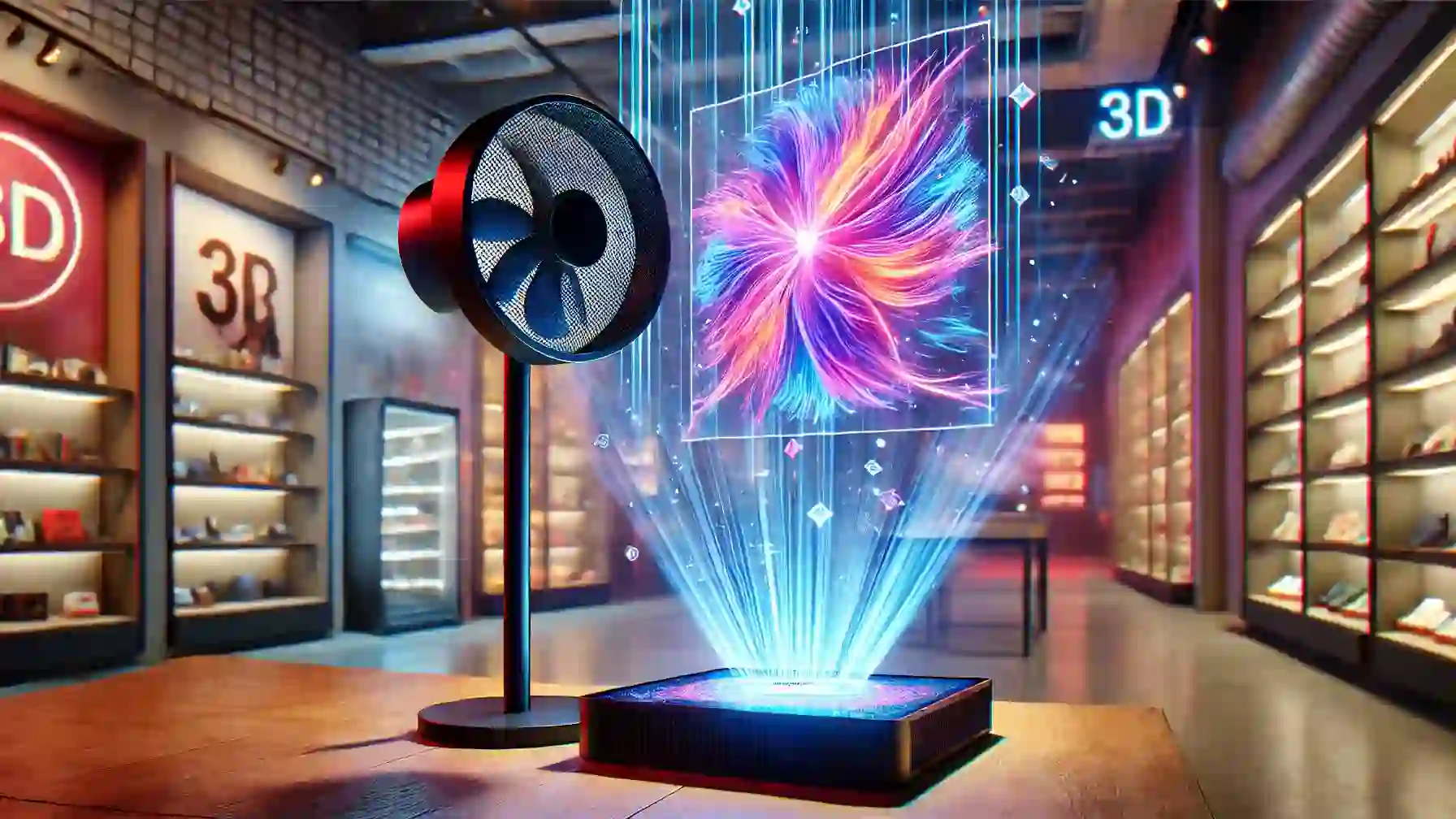The rise of holographic 3D fans is transforming the way we experience visual displays. These cutting-edge devices project mesmerizing 3D images that appear to float in mid-air, offering a futuristic solution for advertisers, event organizers, and businesses alike. With their ability to capture attention and create immersive experiences, holographic 3D fans are quickly becoming a go-to tool for delivering impactful visual content. As industries look for new ways to engage audiences, the unique capabilities of these fans are paving the way for the future of digital displays.
Beyond just eye-catching visuals, holographic fans are versatile and adaptable to various applications. From retail stores and exhibitions to educational settings and entertainment venues, these devices offer dynamic possibilities. The technology is not only exciting but also easy to set up, portable, and capable of delivering high-resolution images from multiple angles. As their popularity grows, holographic displays are set to revolutionize how we interact with media across different sectors.
How does a Holographic 3D Fan work?
At first glance, the concept of a holographic display seems almost futuristic, but the technology is surprisingly simple. A holographic 3D fan consists of LED lights attached to rotating blades. As the blades spin at high speeds, they project moving images that appear three-dimensional to the human eye. This is due to a phenomenon known as persistence of vision, where fast-moving objects blend together, creating a seamless, floating 3D effect.
Also Read: Virtual Reality Experiences Redefine Immersive Adventures
The spinning blades make it seem like the 3D image is suspended in the air, providing an immersive experience that traditional displays cannot match. This captivating technology has proven highly effective in grabbing attention, making it a powerful tool for anyone looking to make an impact with their visual content.
Applications of Holographic 3D Fans:
Advertising and Marketing
The holographic 3D fan is quickly becoming a favorite tool for marketers and advertisers. In a world saturated with digital content, businesses need new ways to stand out, and holographic displays provide just that. Their dynamic, floating images attract attention in crowded areas such as shopping malls, airports, and event venues. Whether it’s a 3D logo or a rotating product display, these fans offer a unique way to engage audiences.
Events and Exhibitions
For event organizers, having a holographic 3D fan can elevate the entire experience. These fans are ideal for exhibitions, product launches, and conferences, providing a “wow” factor that traditional displays lack. Whether it’s for corporate events or public exhibitions, the ability to project interactive 3D content allows businesses to showcase their products or services in a whole new light.
Retail and Product Displays
Retailers are also benefiting from the use of holographic fans. Imagine walking into a store and seeing a 3D display of a product floating in the air. It’s an eye-catching way to showcase products, draw customers in, and even drive sales. From fashion to tech gadgets, retailers can create compelling, futuristic displays that encourage interaction and generate buzz.
Educational and Medical Applications
Beyond the commercial realm, holographic 3D fans are also being used in education and healthcare. In classrooms, teachers can project 3D models of complex subjects, making learning more interactive and engaging. Similarly, in the medical field, holographic displays can be used for educational purposes, showing detailed anatomical models that help students and professionals visualize complex concepts.
Benefits of using a Holographic 3D Fan:
Eye-Catching Visuals
One of the most significant advantages of a holographic 3D fan is its ability to create stunning, high-definition visuals that grab attention. The 3D effect allows businesses and event organizers to create a unique experience, turning heads and drawing people in. This makes it an ideal tool for anyone looking to make their content stand out from the competition.
360-Degree Viewing
Unlike traditional flat screens, holographic fans offer a full 360-degree viewing angle, ensuring that the projected content is visible from all sides. This feature is particularly useful in areas with high foot traffic, where people are constantly moving around and need to see the display from various angles.
Portable and Easy to Install
Despite their futuristic capabilities, holographic fans are relatively easy to set up and transport. Most models are lightweight and portable, making them ideal for trade shows, exhibitions, or businesses looking to update their displays regularly. Installation is simple, usually involving wall-mounting or ceiling brackets, and content can be updated via USB or wireless connections.
Holographic 3D Fans in Advertising:
In the advertising world, grabbing attention is everything, and the holographic 3D fan excels at this. Companies can display their products or logos in a way that truly stands out. The fan projects a 3D image that seems to float in mid-air, captivating audiences and giving brands a futuristic edge. This kind of visual engagement is far more likely to make a lasting impression compared to traditional flat advertisements.
Some brands have already tapped into this technology to enhance their marketing efforts. For example, Coca-Cola famously used holographic 3D fans at a music festival, projecting spinning 3D bottles that mesmerized the crowd. The result? Increased brand engagement, social media buzz, and a memorable consumer experience.
Comparison with Traditional Digital Displays:
When comparing holographic 3D fans to traditional digital displays, the differences are striking. While LED screens can display crisp images and videos, they lack the immersive, three-dimensional effect of holographic fans. Holographic displays create a sense of depth and dimension, allowing viewers to feel more connected to the content.
While holographic 3D fans may be more expensive upfront, their unique impact often makes the investment worthwhile. For brands looking to differentiate themselves, the extra cost is a small price to pay for the attention-grabbing potential these fans offer.
Key Features to Look for in a Holographic 3D Fan:
When shopping for a holographic 3D fan, it’s important to consider key features that will meet your specific needs. Some factors to keep in mind include:
Resolution and Image Quality
For clear, crisp holograms, prioritize fans with higher resolution. Low-resolution models can create blurry or pixelated images, which diminishes the impact.
Blade Size and Rotation Speed
Blade size and rotation speed affect the size and smoothness of the holographic display. Faster rotation speeds ensure that the 3D image appears stable and fluid, while larger blades produce bigger projections.
Compatibility with Media Formats
Look for fans that support multiple media formats, such as MP4 or AVI, to ensure compatibility with your content.
Choosing the right Holographic 3D Fan for your needs
When selecting a holographic 3D fan, it’s important to think about your specific use case. For example, if you’re planning to use it at a large event, you’ll likely need a larger fan with higher resolution to ensure the image is visible to a wide audience. For smaller spaces like retail stores, a more compact fan might be the better choice.

Installation and Maintenance of Holographic 3D Fans:
One of the many advantages of a holographic 3D fan is its ease of installation. These fans are designed to be mounted on walls or ceilings, and they often come with clear instructions for setup. After installation, uploading content is simple and can be done wirelessly or via USB. Maintenance generally involves cleaning the blades and updating software to prevent glitches.
Advancements in Holographic 3D Fan Technology:
As with all technology, holographic 3D fans are continuously evolving. Recent advancements have led to wireless control systems, allowing users to change content remotely. Additionally, artificial intelligence (AI) integration enables interactive holographic displays that respond to user input, creating a more engaging experience.
These innovations are setting the stage for even more impressive applications in the future, potentially integrating augmented reality (AR) and virtual reality (VR) into holographic displays.
Cost Considerations:
Prices for holographic 3D fans vary widely depending on factors such as resolution, blade size, and additional features. While some models may be more expensive than traditional displays, the return on investment (ROI) can be significant due to the increased attention and engagement these fans generate.
Holographic 3D Fans in Entertainment:
The entertainment industry is also embracing holographic 3D fans. Concerts, theater productions, and even sporting events are using these fans to enhance live performances. By creating 3D images that appear to float above the audience, these displays bring a new level of excitement to entertainment.
Sustainability and Eco-Friendly Features:
Many manufacturers are designing holographic 3D fans with sustainability in mind. These fans are energy-efficient, using LED lights that consume less power compared to traditional light bulbs. Their durability also means they need to be replaced less often, reducing waste.
The Future of Holographic 3D Fan Displays
The future is bright for holographic 3D fan technology. With ongoing advancements, we may soon see even more applications, from interactive AR experiences to potential home-use systems. As these displays become more affordable and versatile, they could revolutionize how we interact with digital content in our daily lives.
Conclusion:
In conclusion, the holographic 3D fan represents a significant leap forward in visual display technology. Its ability to project stunning, 3D images that capture attention makes it a valuable tool across various industries, from advertising to education and entertainment. As technology continues to evolve, holographic displays will undoubtedly become even more powerful and versatile, shaping the future of visual communication.
FAQs:
1) What is the lifespan of a holographic 3D fan?
Most holographic 3D fans have a lifespan of around 50,000 hours with proper maintenance.
2) How do you upload content to a holographic 3D fan?
Content can be uploaded via USB or wirelessly, depending on the model.
3) Are holographic 3D fans safe to use?
Yes, they are generally safe, especially when installed according to manufacturer guidelines.
Also Read: The Evolution of 3D Animation: From Pixar to Virtual Reality
4) Can a holographic 3D fan work in bright environments?
While they work best in dim or dark environments, some models have higher brightness levels that perform well in brighter settings.
5) Is there a limit to the size of the projection?
The size of the projection is limited by the size of the fan’s blades. Larger fans produce bigger projections, but space constraints should be considered when choosing a model.








